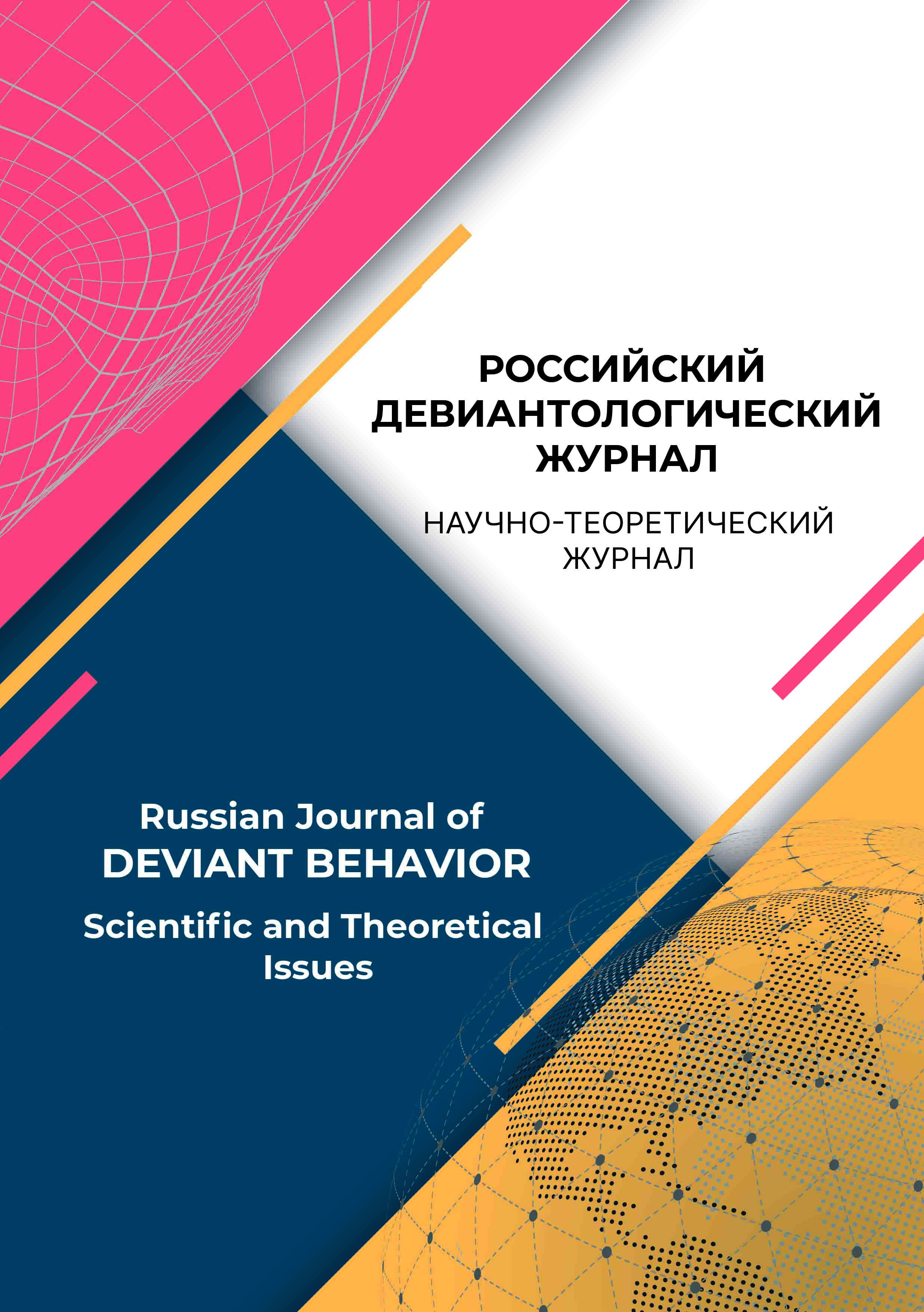Ekaterinburg, Ekaterinburg, Russian Federation
UDC 159.9.072.43
CSCSTI 15.81
World statistics on the use of controlled drugs shows sustainable growth in the number of drug addicts over the last decades. This fact indicates the relevance of solving the problem of identifying the experience of drug use, as well as the development of new reliable methods for diagnosing the tendency towards drug addiction. The technology of non-invasive eye-tracking based on the effects of attention bias and value-oriented attention control can be an alternative to traditional questioning methods (personality diagnostic questionnaires) or polygraph examination procedures. The purpose of the study was to evaluate the possibility of diagnosing drug addiction tendency using eye-tracking technology to detect subjects’ attention bias toward drugrelated stimuli while performing an antisaccadic cognitive task. Methods.The study was conducted as part of a laboratory experiment using the Tobii Pro Spectrum eye-tracker. The study involved 28 respondents divided into 3 contrasting groups: those with systematic experience of drug use; those with single experience of drug use; and those with no experience of drug use. Participants of the experiment were presented with stimulus material “words and images around the dot” on eye-tracker, the elements of which contained stimuli related to the topic of drugs. Data processing was performed using comparative analysis and ANOVA. Results. As a result, it was found that there were significant differences in fixations to addictive stimuli in the contrast groups studied. In addition, qualitative analysis of eye movement scenarios makes it possible to record saccades in respondents with experience of druguse towards images showing drugs, in contrast to the group without experience of use.
addictive behavior, drug addiction, psychophysiological method, eye-tracking, oculography, oculomotor activity, saccades
1. Barabanshchikov, V. A. (2015). Okulomotornaya aktivnost' cheloveka kak predmet i metod psihologicheskogo issledovaniya. V V. A. Barabanshchikov (otv. red.), Ajtreking v psihologicheskoj nauke i praktike (str. 15–34). Moskow: Kogito-Centr. EDN LQWPIV.
2. Barabanshchikov, V. A., Zhegallo, A. V. (2014). Ajtreking: Metody registracii dvizhenij glaz v psihologicheskih issledovaniyah i praktike. Moskow: Kogito-Centr.
3. Bessonova, Yu. V., Oboznov, A. A. (2019). Ajtreking v diagnostike pravdy-lzhi. Institut psihologii Rossijskoj akademii nauk. Organizacionnaya psihologiya i psihologiya truda, 4 (1), 46–86. EDN ZDDJGP.
4. Buhtiyarov, I. V., Zhbankova, O. V., Yushkova, O. I., Gusev, V. B. (2019). Novye psihofiziologicheskie podhody, primenyaemye pri profotbore kandidatov v opasnye professii. Medicina truda i promyshlennaya ekologiya, 59 (3), 132–141. https://doi.org/10.31089/1026-9428-2019-59-2-132-141
5. Vorob'eva, I. V., Kruzhkova, O. V., Matveeva, A. I., Robin, S. D. (2022). Vozmozhnye markery addik¬tivnogo povedeniya pri okulograficheskom issledovanii. Rossijskij deviantologicheskij zhurnal, 2 (4), 397–407. https://doi.org/10.35750/2713-0622-2022-4-397-407
6. Kajdalova, D. A., Kuznecova, A. A., Nikitina, E. A. (2023). Osobennosti glazodvigatel'nyh reakcij pri vospriyatii statichnyh izobrazhenij u yunoshej i devushek so sklonnost'yu k igrovoj komp'yuternoj zavisimosti. Izvestiya Yugo-Zapadnogo gosudarstvennogo universiteta. Seriya: Lingvistika i pedagogika, 13 (4), 164–175. https://doi.org/10.21869/2223-151X-2023-13-4-164-175
7. Kuznecova, A. A., Kajdalova, D. A. (2020). Tekhnologiya okulografii v rannej diagnostike sklonnosti k zavisimomu povedeniyu. Izvestiya Yugo-Zapadnogo gosudarstvennogo universiteta. Seriya: Lingvistika i pedagogika, 10 (2), 180–189. EDN DZFRKV
8. Kupcova, S. A. (2021). Sistema rannej diagnostiki i profilaktiki upotrebleniya psihoaktivnyh veshchestv sredi podrostkov i molodezhi. Pedagogicheskij zhurnal, 11 (6A), 250–260. https://doi.org/10.34670/AR.2021.83.70.032. EDN QGPOHA.
9. Minyurova, S. A., Kruzhkova, O. V., Vorob'eva, I. V., Matveeva, A. I. (2022). Addiktivnoe povedenie podrostkov i yunoshej v sisteme obrazovaniya: obzor psihologo-pedagogicheskih issledovanij. Obrazovanie i nauka, 24 (6), 84–121. https://doi.org/10.17853/1994-5639-2022-6-84-121
10. Prirodova, O. F., Lazarenko, V. A., Nikishina, V. B., Kuznecova, A. A. (2019). Ocenka ustanovochnogo komponenta kognitivnoj zadachi po strukturnodinamicheskim harakteristikam dvizheniya glaz prepodavatelya vuza. Medicinskoe obrazovanie i professional'noe razvitie, 10 (1), 73–83. EDN ZCAELB.
11. Shvajko, D. A., Yanushko, M. G., Shamanina, M. V., Ivanov, M. V. (2022). Vzaimosvyaz' kognitivnogo statusa i parametrov antisakkad u pacientov, stradayushchih shizofreniej. Sibirskij vestnik psihiatrii i narkologii, 4 (117), 22–32. https://doi.org/10.26617/1810-3111-2022-4(117)-22-32
12. Anderson, B. A. (2013). A value-driven mechanism of attentional selection. Journal of Vision, 13, 1–16. https://doi.org/10.1167/13.3.7
13. Anderson, B. A. (2016). What is abnormal about addiction-related attentional biases? Drug and alcohol dependence, 167, 8–14. https://doi.org/10.1016/j.drugalcdep.2016.08.002
14. Dean, A. C., Nurmi, E. L., Moeller, S. J. et al. (2019). No effect of attentional bias modification training in methamphetamine users receiving residential treatment. Psychopharmacology, 236, 709– 721. https://doi.org/10.1007/s00213-018-5100-8
15. Ekin, M., Koçoğlu, K., Eraslan Boz H. et al. (2023). Antisaccade and memory-guided saccade in individuals at ultra-high-risk for bipolar disorder. Journal of Affective Disorders, 339 (3). https://doi.org/10.1016/j.jad.2023.07.109
16. Everling S., & Fischer B. (1998). The antisaccade: a review of basic research and clinical studies. Neuropsychologia, 36 (9), 885–899. https://doi.org/10.1016/s0028-3932(98)00020-7
17. Field, M., Duka, T., Eastwood, B., Child, R., Santarcangelo, M., & Gayton, M. (2007). Experimental manipulation of attentional biases in heavy drinkers: do theeffects generalise? Psychopharmacology, 192, 593–608. https://doi.org/10.1007/s00213-007-0760-9
18. Field, M., Mogg, K., Mann, B., Bennett, G. A., & Bradley, B. P. (2013). Attentional biases inabstinent alcoholics and their association with craving. Psychology of Addictive Behaviors, 27, 71–80. https://doi.org/10.1037/a0029626
19. Mirtorabi, S. D., Saleki, S., Rahmanian, M. S., Hadizadeh, H., Rostami, R., & Yoonessi, A. (2022). Directand Indirect Measures of Attention Indicating a Bias Toward Cues in Methamphet¬amine Users. Basic and Clinical Neuroscience, 13 (4), 455–464. http://dx.doi.org/10.32598/ bcn.12.6.1589.1
20. Parvaz, M. A., Malaker, P., Zilverstand, A., Moeller, S. J., Alia-Klein, N., & Goldstein, R. Z. (2021). Attention bias modification in drug addiction: Enhancing control of subsequent habits. Proceedings of the National Academy of Sciences, 118 (23), e2012941118. https://doi.org/10.1073/ pnas.2012941118













